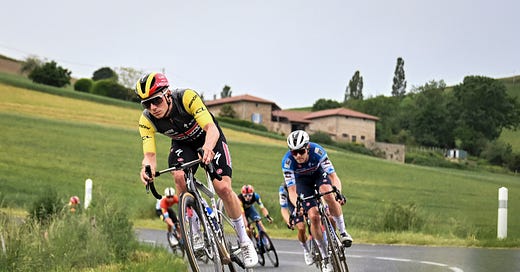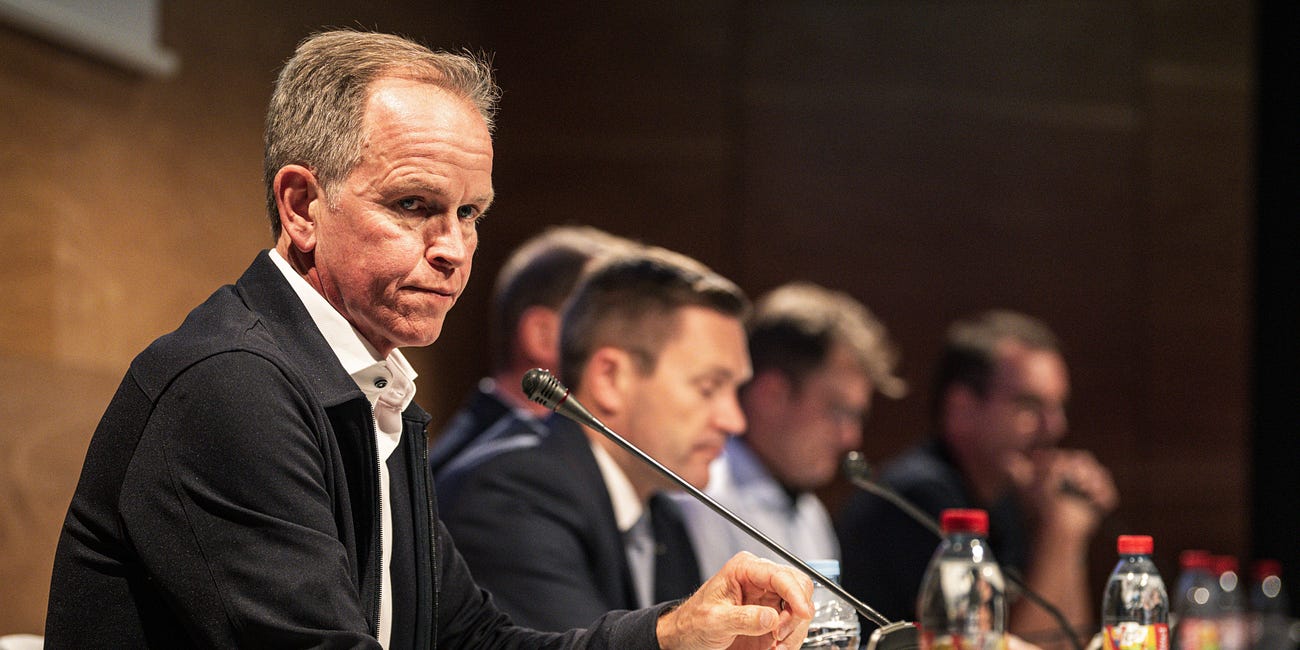The Critérium du Dauphiné Slippéré
Most of the major questions have been answered, including "What happens when you hydroplane on a bicycle?"
Last Friday, I asked six questions about the Critérium du Dauphiné, in its capacity as the primary warmup race for the Tour de France, and through Stage 5 I think we have answers to most of them.
Six Things I Want to Learn From the Critérium du Dauphiné
The eight-stage Critérium du Dauphiné is the most notable warmup race for the Tour de France—most years, the top contenders will break from training to come to either this race or the Tour de Suisse. This is an ASO race, in France, so it carries a little extra verisimilitude for riders who want a taste of the real thing. It’s the most Tour de France a guy can have without taking his yellow jersey off.
What kind of shape are Primož Roglič and Remco Evenepoel in? Pretty good, they finished first and third in the time trial and sit 1-2 (Remco ahead of Roglič) on GC after five stages.
Does Antonio Tiberi have anything left in the tank? No! He dropped 14 minutes on the first mountain stage and didn’t start the next day.
Can Juan Ayuso Geraint Thomas Tadej Pogačar’s Chris Froome? We’ll see. Certainly nothing to this point refutes that notion. Ayuso finished ninth in the time trial and is in the thick of the podium battle. Matteo Jorgenson is third on GC, 1:04 behind Evenepoel, but the next 13 riders are within a minute of him, including Ayuso and most of the serious non-Remco/Roglič GC guys. That last podium spot, at the very least, is wide open.
What’s Josh Tarling cooking up? Second to Remco in the Stage 4 time trial, 17 seconds behind the world champion, who booted the young European champ after a very long day in the hot seat. Feels like holding serve, maybe a minor disappointment for those of us who hoped to see the young Ineos star do something special.
Are we sitting on an Uno-X breakaway machine? Not exactly, but we’ll take it. Uno-X missed on Stage 1, but Magnus Cort survived the culling on the final climb the next day and won the foggy bunch sprint with ease.
Who leads Visma-Lease a Bike? Sepp Kuss took race no. 1 in Jonas Vingegaard’s absence, but it’s Jorgenson, who crushed the time trial and put two and a half minutes into his teammate, who wears the white jersey and represents Visma-LAB’s best GC hope at the moment.
But the headline event of the race so far is the rain-induced demolition derby that marred Stage 5 and led to the race commissaires1 neutralizing the stage. There was some tumbling around in the breakaway early on—Ådne Holter of Uno-X just could not stay upright—before a massive crash with about 20 kilometers left took out just about everyone.
I usually try to link something more concise than the massive (but useful) extended highlights published by NBC, but this is worth seeing. The big crash is at about 10:30 in this video.
Richard Plugge, the Visma-Lease a Bike boss and sometime bringer of the wooden horses inside the city gates, remarked that if such conditions had been evident in Formula 1, officials would’ve called the race off sooner.
Knowing what little I do about Plugge, I assume this remark was meant to prod the UCI leadership and race officials into taking a more active role in a sport that can be self-conscicously small-time.
Don't Let the Goddamn Visigoths In
Late last year, I decided to start writing seriously about cycling, after having covered other sports, mostly baseball, for more than a decade. One of the things I love most about cycling—and the thing about the sport that’s probably most alien to the American audience I had set out to court—is the structure of its top-tie…
Nevertheless, I find the comparison intriguing. Because the conditions that ailed the riders on Thursday make for some of the best open-wheel auto racing.
When it rains, road conditions are affected in three ways: First, the surface gets cooler, which is a huge change for cars, less so for bikes. Second, the surface gets slippery because there’s standing water. Third, the surface gets slippery because all sorts of flotsam and jetsam that’s ordinarily caked into the asphalt—tire rubber, sand, oil and other fluids and lubricants that leak from passing vehicles—gets agitated, floats to the surface, and stays there until the road dries out.
A slippery surface is challenging for cars, which are faster than cyclists2 but have four wheels3 with bigger contact patches that can be swapped out for rain tires. And when a car crashes, the driver is protected by seatbelts and a fire suit and helmet, roll cages, and so on—it’s very rare for a modern F1 or IndyCar or NASCAR driver not to walk away from an accident.
Cyclists are not only more precariously balanced, with skinny little tires and only two of them to boot, they’re bunched up into a flock, more than 100 of them at a time, rather than spread out evenly over several miles’ worth of race track. And because cycling takes place on public roads, rather than closed circuits, it’s impossible for the officials to monitor the road conditions throughout, or to throw caution flags4
So when 100-plus riders are sliding along elbow-to-elbow, each with his own level of feel for grip and comfort on the bike, when one hits the deck they all hit the deck. In the TV coverage there was a shot of what was left of the peloton after the crash: Just four riders, including Jorgenson and Kuss.
There were a few major casualties—Plugge was probably feeling a little pissy because he lost two riders, Steven Kruijswijk and Dylan van Baarle—but for the most part I agree with Evenepoel’s assessment of the incident: It could’ve been a lot worse.
I think everyone was on edge for this wreck not just because it was big, or because there were unusually large patches of standing water on the road, but because it included two Tour de France favorites who’d only just gotten back on their bikes after the horrific Tour of the Basque Country crash earlier this spring.
Both Evenepoel and Roglič got beat up in this crash, and Evenepoel stayed down for a while, but neither broke or dislocated anything. It’s not what you want on what was supposed to be a fairly uneventful stage leading into a brutal weekend in the mountains, but these guys are tougher than you or I can imagine—they’ll live with some scrapes and bruises.
What struck me about this crash was the contrast to the Tour of the Basque Country incident in terms of speed and terrain. This was also on a descent, but not a particularly fast one. And where the Basque Country crash dumped a dozen riders straight into a concrete culvert, these roads were bordered by gentle inclines covered in thick grass. If you’re going to go over your handlebars, that’s about as safe a landing spot as can be hoped for.
Is there anything more to be done? I tend to say no. The race was neutralized within seconds of the peloton breaking up. Maybe the commissaires could’ve had a quicker trigger for wet roads, but it wasn’t raining that hard. A happy medium might be posting the equivalent of local caution flags, but that requires manpower in terms of marshals and track monitoring that organizers simply don’t have. It was a bit startling to watch, and it’s only by good luck that the big stars escaped injury, but it’s racing. It’s part of the game.
Finally, the Tour de Suisse kicks off with a prologue on Sunday, just as the Dauphiné is ending. There’s not as much GC firepower at the other Tour de France warmup race, but it’s still an impressive startlist. The style these days is for big teams to throw every GC rider they have who’s worth a damn into the Tour de France and either put all their eggs in their best rider’s basket or figure out who’s feeling good heading into the mountains and figure it out from there. And in preparation, the style also seems to be to split up the big guns in the warmup races.
So UAE sent Ayuso to the Dauphiné, but Adam Yates and João Almeida are going to the Tour de Suisse. EF sent Neilson Powless to the Dauphiné, but Richard Carapaz is going to the Tour de Suisse. For Ineos Grenadiers: Carlos Rodríguez to the Dauphiné, Egan Bernal to the Tour de Suisse.
As for the route: It’s going to be a lot of climbing. Which I guess is, again, obvious, because it’s Switzerland. The last five stages all have uphill finishes, including the race-ending individual time trial, two-thirds of which by distance is a climb up a 10.2 km, 8% incline.
One rider I want to highlight is Carapaz, who needs to prove that he’s still got the grand tour GC chops he showed with Movistar and Ineos. At his best, Carapaz is a dynamic, punchy, aggressive climber who suffers against the clock. He won the Tour de Suisse in 2021, and I don’t think he’s ever going to get a friendlier parcours in a World Tour stage race. But you know who else this terrain suits? Rodríguez, Yates, Felix Gall, Enric Mas, Fausto Masnada…so yeah, this should be a challenge.
Have a good weekend, everyone, and look out for greasy spots on the road.
Don’t turn around, oh-oh
Obviously
to the extent that those even exist in road cycling







